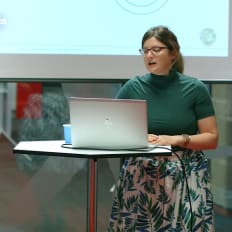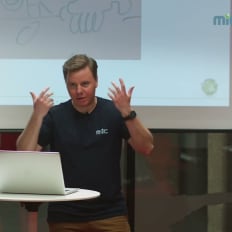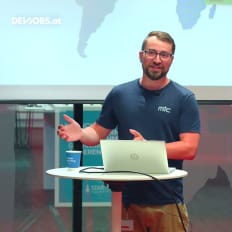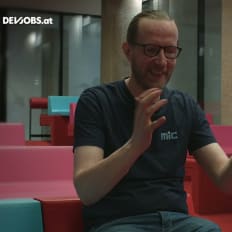
MIC
Clemens Kriechbaumer, Team Manager Data Science bei MIC
Description
Clemens Kriechbaumer von MIC spricht im Interview über den Aufbau des Data Science Teams und dessen Themenschwerpunkte, die dort eingesetzten Technologien und wie dort das Recruiting gestaltet ist.
By playing the video, you agree to data transfer to YouTube and acknowledge the privacy policy.
Video Summary
In "Clemens Kriechbaumer, Team Manager Data Science bei MIC," Clemens Kriechbaumer outlines an eight-person, international Data Science team split into Analytics (data engineering, visualization) and ML/AI that works end-to-end on a modern stack (Python/PyTorch & Lightning, Kubernetes with Flyte, TorchSurf for inference, ClickHouse, Apache Superset; dbt planned; REST APIs via Spring Cloud Gateway). He highlights a collaborative, English-speaking culture and the strategic choice to keep analytics and ML in one unit to own the path from training to production and rapidly prototype with LLM APIs. Hiring favors a relaxed, practice-based approach: after a short first interview, MIC hosts an organized in-office “Look and Feel” half day (travel arranged) where candidates present their own projects—ideally from GitHub—with emphasis on engagement, presentation, and technical depth rather than coding quizzes.
Building an 8‑Person, End‑to‑End Data Science Org at MIC: Lessons from Team Manager Clemens Kriechbaumer
One team, two disciplines—and a single mission
In “Clemens Kriechbaumer, Team Manager Data Science bei MIC,” we heard a crisp blueprint for making Data Science work as an end‑to‑end discipline. MIC has been working on Analytics and Machine Learning for more than two and a half years; the dedicated Data Science team was formed about a year and a half ago and now counts eight people. The structure is deliberate:
- Analytics (Data Engineering & Visualization): moving data between platforms, modeling and transforming it, building visualizations
- Machine Learning / Artificial Intelligence: training models, presenting results, and operating inference systems
Even though the day‑to‑day work differs, keeping both areas under one roof is a strategic choice. It creates a continuous path from raw data through transformation and training to the delivery of insights and production models. Over time, such a setup could evolve into a broader organizational structure—but right now the cohesion drives speed and coherence.
The team is international and collaborates in English, reflecting both the open tool stack and a culture of constant learning.
Culture: Generalists first—then deep specialists
A repeated theme in the session: MIC looks for generalists who understand how the pieces of modern IT fit together. The stack spans Python, Kubernetes, databases, Java‑based REST APIs, and workflow engines. With that foundation, people specialize—whether that’s Python for ML, Kubernetes‑based orchestration, or data modeling.
“The skill set in our team … I prefer generalists who know how things connect in IT. Then you can specialize—be an expert in Python, do more Machine Learning, or focus more on Kubernetes—but you need that generalist base.”
The team deliberately works with state‑of‑the‑art tech in both ML and analytics, balanced with a pragmatic mindset: LLM APIs where they make sense; in‑house models where MIC has the data and specificity. That creates real ownership from pipelines and training to dashboards and APIs that customers actually use.
Hiring that surfaces substance: a “Look and Feel” instead of trivia quizzes
The recruiting process mirrors the culture. It starts with HR and the hiring manager defining the profile, followed by pre‑screening and an initial conversation (~45 minutes, online or in person). The defining step is the on‑site “Look and Feel” at MIC:
- Invitation to the office (travel is organized)
- 2–3 hours together: the team introduces itself and demos projects/technologies
- Candidates are encouraged to present their own projects (e.g., GitHub)
Kriechbaumer explicitly avoids programming trivia. What matters is what candidates have built, can explain, and can defend in detail—showing engagement, technical depth, and communication skills. If both sides agree, the process moves to discussing terms and then to salary/contract.
“I’m a big fan when someone has a GitHub project they’ve really lived with and can explain. You see the engagement and the ‘fire’—and you get a better read on skills than with classic interview questions.”
It’s a process designed to evaluate real‑world capability—the exact thing that shows up on the job.
ML at MIC: Python, PyTorch, Kubernetes—and orchestration that actually works
MIC’s ML stack leans on proven open‑source tools and a production‑minded operating model:
- Language: Python—the productive backbone of the AI work
- Training: PyTorch, complemented by PyTorch Lightning for reliable GPU handling
- Infrastructure: Kubernetes as the abstraction layer for hardware resources
- Orchestration: a Kubernetes‑specified workflow engine (Flight) to control long‑running training jobs
- Artifact management: versioned storage of trained models, e.g., on S3‑compatible storage
- Inference: models run in the Kubernetes cluster with on‑demand GPUs; currently using TorchSurf from the PyTorch ecosystem
Being able to spin resources up and down on demand is essential. Some models fit on a single GPU; others require multiple GPUs, and large models might span several nodes. Training can take hours to days—so the orchestration layer has to be robust:
“Start GPUs, kick off training, monitor the process, do post‑processing, and store the finished model. Versioned and reusable.”
Inference is treated as seriously as training. A model only creates value when it responds reliably and scalably in the cluster.
LLMs with pragmatism: APIs for breadth, fine‑tuning for depth
MIC is actively experimenting with Large Language Models. The path described fits many mid‑sized environments:
- For broad, general use cases: use external APIs (e.g., OpenAI) and build quick prototypes
- For specific domains: train specialized models where MIC owns the data; fine‑tuning is a realistic lever
The balance is the point: few organizations will train general‑purpose LLMs from scratch, but coupling API‑based breadth with targeted fine‑tuning for core processes produces speed and relevance.
Analytics at MIC: From normalized transactions to denormalized insights
On the analytics side, MIC is methodical and transparent about priorities:
- Source systems: highly normalized relational databases for the operational software. The focus is clean transactional processing (ACID), compliance, and in‑time availability. In MIC’s domain this includes correctly handling business processes like customs declarations—analytics comes second.
- Target platform: ClickHouse as the open‑source analytical database. It’s very fast and simple to operate—critical benefits for a lean team.
- Movement & orchestration: periodically pulling data into the analytics environment; the direction is towards Kubernetes here as well, with a workflow engine for recurring jobs.
- Transformation: denormalizing for fast queries on flatter structures; DBT is planned for transformations.
- Visualization: Apache Superset for self‑service BI—dashboards and charts without development effort and with a variety of visualizations.
Empowerment is central. Customers can assemble their own dashboards, build aggregations, and explore data. The team aims to move users away from Excel silos and into transparent, reusable visualizations in a modern tool.
“We want to empower business users to build it themselves … you click together dashboards, group, aggregate—no development needed.”
Transparency extends beyond visuals: MIC exposes REST APIs so enterprises—such as those in automotive—can programmatically access their data. On this path, Java is still the tool of choice, including a Spring Cloud Gateway.
Why this setup appeals to engineers
From our DevJobs.at editorial perspective, several concrete reasons make this team compelling for data and ML talent:
- End‑to‑end ownership: from operational sources through ETL and transformation to training and delivery (dashboards or APIs)
- Modern, proven tools: Python, PyTorch, Kubernetes, ClickHouse, DBT (planned), Apache Superset, Java‑based gateways
- Orchestration that scales: Flight for long‑running ML jobs—resource control, monitoring, and post‑processing included
- Real operations: inference in cluster with on‑demand GPUs—not just prototypes but production‑minded serving
- LLM pragmatism: APIs where they accelerate value; fine‑tuning for specialized needs
- Self‑service analytics: Apache Superset for customer‑built dashboards—immediate impact for BI enablement
- Transparent data access: REST APIs as first‑class products—no data silos
- International, English‑speaking teamwork: openness to global profiles and clear collaboration
- Hiring that values practice: “Look and Feel” with project walkthroughs—ideal for builders who want to show substance
If you see yourself as a broad‑minded builder of robust, production‑grade data and ML systems—and then drill down for mastery—MIC offers many ways to have impact.
A learning mindset close to the frontier
Kriechbaumer shared that after studying business informatics he completed an AI master’s program in 2019 to engage with new technologies. That orientation shapes the team’s work:
- Staying current in ML: frameworks, training methods, and metrics—evaluated and applied continuously
- Technology fitness: Kubernetes, workflow engines, databases—standardize where it helps, stay open where it matters
- Prototyping with LLM APIs: quick experiments, validation, and iteration
Most importantly, growth happens around real product needs. Training alone isn’t enough—you also need dependable operations, versioning, API access, visualization, and customer value. Team members learn exactly what modern data organizations require to ship.
Day‑to‑day collaboration: mastering the seams and presenting results
The team covers the key seams in a data product lifecycle:
- Data engineering: automate flows from operational systems, publish to ClickHouse, and run scalable transformations
- Machine learning: train, monitor, version, deploy, and operate models
- Visualization & enablement: make KPIs visible via dashboards; enable business users to build their own
- APIs & integration: provide and secure REST interfaces so customer systems can consume data in a controlled way
Presentation matters. The people who train models also present them—and handle detailed questions. That expectation starts in hiring and continues in delivery.
What MIC expects from new team members
Based on the session, candidates should bring:
- A broad understanding of the IT landscape (from data models to Kubernetes)
- Willingness to specialize (Python/ML, Kubernetes/orchestration, data modeling/BI)
- Ability to present and discuss their work (including detailed follow‑ups)
- Pragmatism in tooling (open‑source, APIs, on‑demand resources)
- Comfort in an international, English‑speaking environment
A strong way to stand out is to bring one or two projects you can walk through—your role, architectural choices, and results—ideally something you can explain in the “Look and Feel.”
A note on domain reality: business processes first, analytics as a focused layer
A helpful reality check from the session: operational systems exist to process transactions correctly. In MIC’s world that includes handling customs declarations. Analytics follows as a separate layer—transforming and denormalizing data for reporting and dashboards. That sequence is a feature, not a bug: only on the shoulders of sound processes can analytics and ML produce reliable value.
Conclusion: An end‑to‑end team that gives engineers room to own and grow
“Clemens Kriechbaumer, Team Manager Data Science bei MIC” showcased an organization that treats Data Science as a production discipline across the entire stack. From Kubernetes‑orchestrated training to on‑demand inference and versioned model storage—and from ClickHouse‑powered analytics to Apache Superset dashboards and REST APIs—the team removes handoff friction and gains speed.
For talent seeking responsibility, that is compelling. The hiring process rewards substance over trick questions; the tech stack is modern and open; the collaboration is international; and the learning curve is steep. With eight people, individual impact remains visible—every single day.
More Tech Talks
MIC Technical Agile Enabling
Pia Otter-Bäck von MIC gibt in ihrem devjobs.at TechTalk Einblick darüber, wie im Unternehmen das Thema Technical Agile Enabling umgesetzt wird.
Watch nowMIC 7 Powerful Questions to ask your Development Teams
Philipp Dressler von MIC spricht in seinem devjobs.at TechTalk über sieben Grundgedanken, anhand welchen ein Team von Developern reibungslos zusammenarbeiten kann.
Watch nowMIC The MIC Tech Radar
Wolfgang Gassner von MIC zeigt in seinem devjobs.at TechTalk die Herangehensweise, wie im Unternehmen die riesige Zahl an verwendeten Technologien überschaubar gehandhabt werden.
Watch nowMIC Organization for Fast Flow
Gerald Schweizer von MIC beleuchtet in seinem devjobs.at TechTalk die wesentlichen Gedanken, wie und warum die Organisation der Development Teams im Unternehmen verändert worden ist.
Watch nowMIC How our career paths help you grow as a Software Engineer
David Theil von MIC erläutert in seinem devjobs.at TechTalk die grundlegenden Gedanken, welche hinter den verschiedenen Rollen als Software Engineer im Unternehmen stehen.
Watch now







